Blog
Freshwater Depletion: Realities of Choice
November 26, 2014 at 1:39 PM
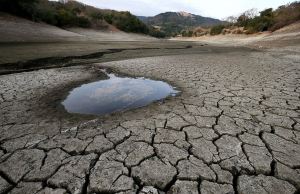
Let’s get it right: it’s not drought or climate change that is wreaking havoc on water supplies in California or anywhere else in the southwest U.S. … it’s what we are eating.
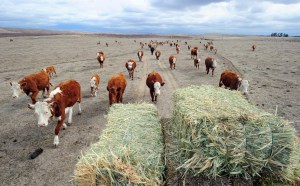
60 Minutes, Leslie Stahl, and the real issue at hand
On November 16, CBS aired a 60 Minutes episode called “Water,” where Leslie Stahl reported to over 12 million viewers “new evidence” that our planet’s groundwater is being pumped out much faster than it can be replenished. The story focused primarily on the scarce water conditions in California. While Ms. Stahl’s findings were important to emphasize, they were nothing new. Whether in California or globally, audiences will eventually need to hear the truth about freshwater scarcity as it relates to our current and projected water-management trends: where all of our freshwater supplies are going and what we can do about it.
Those living in California and the Southwest U.S find themselves embedded in a significant four-year drought and have turned to strategies such as rationing water, educating the public about conventional conservation tactics (such as shortening shower times), and even approving $500 fines for overwatering lawns.
On average 2 to 3 gallons of water can be saved by reducing your time in the shower by one minute or by turning the water off while brushing your teeth. However, you can save more than 1,000 gallons per day by eliminating meat and dairy from your diet. That’s the average amount of water required to produce the nine ounces of meat that every American consumes per day, on average.
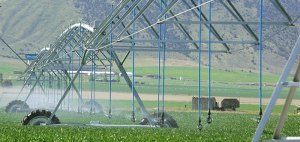
Raising livestock plunders global resources and devastates our water supply
In some areas of the southwest U.S., including California, it requires over 4,000 gallons of water to produce just one pound of beef and over 1,000 gallons to produce just one gallon of milk¾as compared to, on average, 6 to 30 gallons to produce a pound of vegetables, such as carrots or various greens.
Using land and water to raise livestock and to grow crops to feed them is a tremendously inefficient way to produce food. It wastes energy, resources, and lives. With a burgeoning global human population expected to reach 9.6 billion by the year 2050 (2.5 billion more than we have now), there will come a time where growing plants for direct human consumption will be the only socially (and perhaps legally) acceptable way to deploy our finite resources for food production, whether in California or anywhere else in the world.
The state of California raises over 6 million cattle and 2 million dairy cows. Each animal drinks between 20 gallons (grazing beef cattle) and 40 gallons (dairy cow) of water daily. An additional 2 million annual gallons of virtual water (the amount of water used in the entire production process of an agricultural product) are tied up in grain and pasture to feed just one cow. Annually, this is over 100 times more water than one human drinks and is 130 times more than what is used to produce food for one person each year if eating a purely plant based diet.
Pastured livestock: far from sustainable
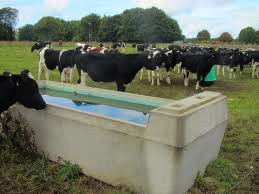
Many people consider raising livestock on pasture to be a more “sustainable” way to produce meat and dairy. But if we examine the water that just one of the two billion grass-fed cattle in the world drinks (not accounting for the significant additional water required for feed, slaughtering, or processing), it would still require 20,000-22,000 gallons over a 24-month period to raise just one grass-fed cow. That amount of water is the equivalent of a person taking a five-minute shower each and every day for 6.7 years. Indeed, when accounting for land and water use inefficiencies, net greenhouse gas emissions, effect on biodiversity, and ratios of end product consumed per resources required, pastured animal agricultural systems are LESS sustainable than factory farming.
Loss of the Colorado River via alfalfa
Every year, California devotes 900,000 acres of its land to growing alfalfa, ninety-five percent of which is eaten by cattle (the other five percent by horses). Each one of these 900,000 alfalfa acres receives irrigation to the tune of 1 to 2 million gallons per year (50-80 acre inches per acre per year). Therefore, total freshwater used in California for just one year of hay production is 1.8 trillion gallons.
Each year, California uses 1.8 TRILLION gallons of freshwater to produce hay for livestock.
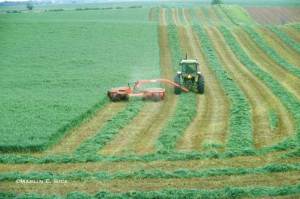
In California’s Imperial Valley, one-fifth of all the water from the Colorado River is diverted through the Imperial Canal, and 70 percent is used in one way or another for livestock. The average yearly rainfall in the Imperial Valley is less than 3 inches, and water is sparse in other areas in California where alfalfa hay is grown.
Knowing this, it is shocking that the largest importer of California hay for the past few years has been the United Arab Emirates (UAE), which is importing hay because it is concerned about the scarce water supply for its own citizens. Saudi Arabia will soon follow, essentially importing water from California via hay for its animals, which are then consumed by Saudi citizens. This virtual water trading loss will be a growing trend—certain countries depleting the natural resources of other, more unaware countries, such as the U.S., Brazil, and others, so they may “prosper” with importation of animals and animal products.
These animals are produced in all countries where true environmental costs of production continue to be externalized, and a proper economic metric has yet to be affixed to the raising and slaughtering of livestock and fish, the largest contributors to global depletion. Opportunistic countries with dwindling natural resources will continue to take an approach similar to that of the UAE by utilizing their limited water supply more for human consumption than for crop or animal production, while taking advantage of countries such as the U.S., which doesn’t know any better or is letting economics dictate ecological reasoning.
Historically, the U.S. has heavily subsidized use of aquifer water for livestock and feed crops, such that farmers in the Ogallala and San Joaquin regions of the western U.S. (home of two of the largest aquifers on Earth) pay only 5 to 10 percent as much for their water as do residents in those areas. This has encouraged continued alfalfa and feed crop production and freshwater depletion.
“Subsidence”: ground craters where water once lived …
Typically, most areas of the world predominantly use either surface water (lakes, streams, rivers) or groundwater (aquifers). California uses a combination of both, in an approximately 60/40 ratio, blending the surface waters of the Sacramento-San Joaquin River Delta and the diverted Colorado River with underground water from the San Joaquin aquifer and others. In times of drought, California places restrictions on surface water and relies heavily on withdrawals from aquifer systems.
Visual indicators of these water withdrawals can be seen in many areas, most notably, perhaps, near Mendota, California, where a 1977 study showed land elevation having dropped as much as 28 feet in some areas. Known as subsidence, this phenomenon occurs when ground cratering results after excessive amounts of groundwater have been withdrawn from an aquifer. Once water has been removed from the sediment and subsidence has taken place, it cannot be replaced.
Subsidence can also be readily seen in many Texas counties and elsewhere in the world. It is occurring in the state of Guanajuato, Mexico, where the water table is falling by 2 meters or more per year, due to the withdrawals required to support the growing livestock and feed crop industry there.
Worldwide, there are many examples of rapid groundwater depletion. India is witnessing losses due to the irrigation of rice fields, and the North China Plain is quickly depleting its two aquifer systems because of expansion of animal agriculture. In the U.S., there is depletion of aquifers due to livestock and feed crop operations in North Carolina, Arkansas, the Columbia River Basin, and especially in California’s Central Valley, the focus of Ms. Stahl’s report.
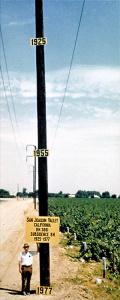 “The single largest human alteration of land”
“The single largest human alteration of land”
The San Joaquin Valley forms the backbone of California’s agricultural industry, the nucleus of the Central Valley area, which produces 25 percent of the nation’s food on less than 1 percent of the country’s farmland. Land subsidence in excess of 1 foot has affected more than 5,200 square miles of irrigable land—one-half the entire San Joaquin Valley. The USGS has called this “the single largest human alteration of land.” It, along with depletion of the Ogallala, will likely be the single largest human alteration of water, as both the San Joaquin and Ogallala aquifers are expected to be completely drained in coming decades (within sixty years for the former and as soon as 2030 for the latter).
Abuse of the Ogallala
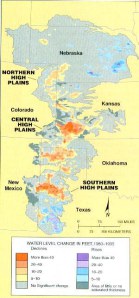 At an average depth of 200 feet, the Ogallala is the most heavily depleted aquifer in the U.S. and the world’s fastest-disappearing freshwater source, having lost 150 feet of depth in the past twenty years. It contains water formed from glaciers 12 million years ago, has a recharge rate of less than a half-inch per year, and is being drawn down at a rate of 3 to 10 feet per year.
At an average depth of 200 feet, the Ogallala is the most heavily depleted aquifer in the U.S. and the world’s fastest-disappearing freshwater source, having lost 150 feet of depth in the past twenty years. It contains water formed from glaciers 12 million years ago, has a recharge rate of less than a half-inch per year, and is being drawn down at a rate of 3 to 10 feet per year.
Since the 1960s, farmers have irrigated this land, receiving subsidies to use this water to grow crops to feed cattle. Almost half of all cattle raised in the U.S. come from just four states in this area—Nebraska, Iowa, Kansas, and Texas, which accounted for 49 percent of the United States commercial red meat production in 2010.
The vast majority of the Ogallala abuse and depletion has occurred in support of the largest cattle herds in the U.S. and the corn that feeds them¾a vivid example of just how much power various influences exert over our decisions about food. When confronted with the very real potential of running the Ogallala aquifer dry, a movement in the late 1980s supported creating a pipeline to pump water from Lake Michigan, one of the great lakes, back to all the livestock operations. This brings us front and center to the real problem—water management and food choice.
We need to find another solution. We could, for instance, eat all plant-based foods, which are far less water intensive. We do not need to eat cattle from the High Plains states or anywhere else to live thriving, healthy lives. We do, however, need water.
Water by the numbers, globally and in the U.S.
Worldwide, alfalfa is grown on approximately 79 million acres. The majority of it is irrigated, and 70 percent of it comes from the United States, Russia, and Argentina—countries suffering now from frequent periods of heat, drought, and water stress. Wherever water scarcity is found in the world, particularly with irreversible overdrawing of aquifers, livestock is typically involved, leaving the indelible mark of our insatiable demand to eat them.
Between 50 and 75 percent of all water withdrawal from the largest aquifers in the world—the Ogallala, North China Plain, San Joaquin, and Columbia River Basin—can be attributed to livestock and the alfalfa, corn, sorghum, and other crops they eat, the water they drink, and the water used to generally service and slaughter them, as well as to the processing and packaging of animal products.
In the U.S., livestock consume 34 trillion gallons of water per year, accounting for nearly 50 percent of all freshwater-consumptive withdrawals.
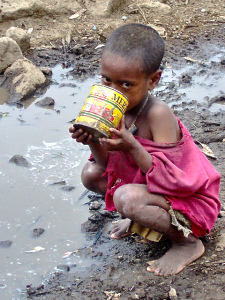
Each year, the U.S. livestock industry uses 34 TRILLION gallons freshwater.
Globally, agriculture is responsible for 92 percent of all freshwater use, 30 percent of which goes to livestock and crops or pasture to feed them.
The China connection
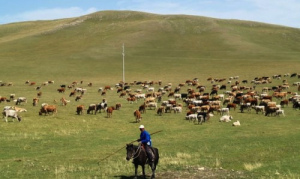 Most of China’s arable land and freshwater supplies are polluted and dwindling, so they are turning elsewhere to help supply their growing demand for pork, dairy, and other meat products. China’s demand for meat has quadrupled since 1980, and it now consumes over 50 percent of the world’s production of pork and 60 percent of the world’s soybeans. Feed crops such as corn and even wheat grown in drought-ridden areas of the U.S., such as the southwest and middle corn belt, are irrigated with water from rapidly depleted ancient aquifers to feed livestock grown in China and elsewhere, while U.S. policy makers are scratching their heads to find solutions to a growing freshwater scarcity issue.
Most of China’s arable land and freshwater supplies are polluted and dwindling, so they are turning elsewhere to help supply their growing demand for pork, dairy, and other meat products. China’s demand for meat has quadrupled since 1980, and it now consumes over 50 percent of the world’s production of pork and 60 percent of the world’s soybeans. Feed crops such as corn and even wheat grown in drought-ridden areas of the U.S., such as the southwest and middle corn belt, are irrigated with water from rapidly depleted ancient aquifers to feed livestock grown in China and elsewhere, while U.S. policy makers are scratching their heads to find solutions to a growing freshwater scarcity issue.
Robert Glennon, a water policy expert at the University of Arizona, calculated that approximately 100 billion gallons of western U.S. water—enough to supply the annual household needs of one million families—were being exported to China in the form of alfalfa crops grown with irrigation water from the Colorado River and dwindling aquifers in California and Arizona.
Refocusing of issues—animal agriculture, climate change, and global depletion
Regarding sustainability issues, most of the world’s attention recently has been focused on climate change and greenhouse gas emissions—energy and fossil fuel use. But climate change is only one component of the much larger, more insidious concern of global depletion. It is an exacerbator, taking these pressing issues and making them worse.
Climate change is not the sole cause of various aspects of global depletion, such as agricultural land use inefficiencies, oceanic ecosystem devastation, rainforest deforestation and degradation, food insecurity, accelerated extinctions and loss of biodiversity, and freshwater scarcity. All of these phenomena are occurring with or without the effects of climate change … with or without the use of fossil fuels. The primary driver of all of these combined issues worldwide is the raising, harvesting, slaughtering, and consumption of animals.
Regarding our state of sustainability, make no mistake that we are in overshoot mode. According to the Global Footprint Network, it would require more than 1.5 Earths to sustain what we are currently taking from and doing to our planet, and no other single factor contributes to our unsustainability as significantly as our demand for meat, dairy, fish, and eggs and the agricultural systems that support these products.
Timelines of Irreversibility
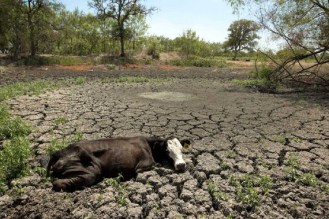
All aspects of global depletion are marked by timelines—the number of years before tipping points may be reached and thus cause irreversibility. To wit:
- Global warming: Most researchers agree that our planet will display irreversible effects if we have not drastically reduced greenhouse gas emissions by 2017.
- Oceans: With massive loss of sea life (90 percent of all large fish species are gone) due to commercial fishing, warming waters and 30 percent acidification, irreversibility has already occurred in our oceans. It has been 300 million years since the last time our oceans have been this warm and acidic and at that time, it took over 30 million years to recover.
- Tropical Rainforests: Since 1978 over 300,000 square miles of tropical rainforest in the Amazon have been destroyed. Ninety percent of the destruction in Brazil and between 70 and 80 percent of rainforest destruction in the other seven Amazonian countries has been due to grazing livestock and to grow feed crops. The diverse wildlife lost will never be seen again in our lifetime.
- Species extinction: Similarly, with the massive number of species extinctions (occurring at up to 10,000 times the annual background rate) and loss of biodiversity, we are already witnessing irreversibility. For some species with whom we share this planet, time has already run out. Cause of extinction: humans.
… And so it is with the availability of freshwater.
One of our most critical concerns regarding sustaining current and future life on Earth is our supply of freshwater. From 1941 to 2011 the world’s population tripled, but freshwater consumption quadrupled. The gap between worldwide demand for water and what is really available is growing at such a rate that a 40% shortage in water supply is expected in just 15 years.
Water and geopolitics
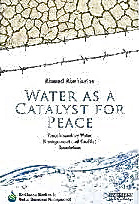 Although the amount of water on earth remains constant, the consumptive form it happens to be in does not. Four out of five people now live within 30 miles of a water-damaged area (meaning soon to run out, or polluted), and there are nearly 300 transboundary river and waterways on Earth where multiple countries share vital running water supply. As we see water shortages over the next fifteen years, we will surely see droughts, famine, and human sickness. And then we’ll see conflicts, social unrest, and even wars. Indeed, those living downstream will be fiercely battling those living upstream for water rights.
Although the amount of water on earth remains constant, the consumptive form it happens to be in does not. Four out of five people now live within 30 miles of a water-damaged area (meaning soon to run out, or polluted), and there are nearly 300 transboundary river and waterways on Earth where multiple countries share vital running water supply. As we see water shortages over the next fifteen years, we will surely see droughts, famine, and human sickness. And then we’ll see conflicts, social unrest, and even wars. Indeed, those living downstream will be fiercely battling those living upstream for water rights.
Climate change will make these matters worse, but it will not cause them. Food choice and virtual water trading through food, especially with animal products, will play much larger roles than energy and fossil fuel use.
As we continue irreversibly damaging the environs that support us and all other life on Earth (lithosphere, hydrosphere, and atmosphere) and begin running out of freshwater, topsoil, arable land, fish in our oceans, and tropical rainforests¾creating extinctions of other species and loss of biodiversity¾we will come to accept that sustainability of our own species is contingent upon the choices we make. While scientists and policy makers are concerned about advancing technologies, we should be first concerned about our decisions, particularly those decisions that have the most profound effects on the health of our planet and our own health, such as food choice specifically related to animal agriculture.
The easiest solution to any area of global depletion can be found by adopting a more optimal level of relative sustainability—and to do so today, as the timelines of irreversibility are imminent and the clock is ticking.
A plea for equal time
As usual, 60 Minutes and Ms. Stahl’s “Water” segment presented an entertaining story to over 12 million viewers with a report of a real-life problem, consisting of selected interviews, a possible solution, and even a sprinkling of space technology (GRACE satellite information). But instead of resorting to “toilet-to-tap” recycling of waste water as perhaps the last resort to solving our problem of freshwater scarcity as indicated in the report, we need to hear where the overwhelming majority of our water is going and how this relates to the profound issue of agricultural system inefficiencies. We need to hear about the most sensible manner in which we can produce food … and why it needs to be done today.
Let’s move the critical mass in the right direction and do so now. Let’s all contact Ms. Stahl, asking her to seriously consider reporting on how animal agriculture is the sector most responsible for global depletion. Ask her to clearly spell out to her massive audience that the timelines necessary for action are upon us and that immediate and complete replacement of animal products by organically grown, whole-plant-based food alternatives is necessary to ensure the highest level of relative sustainability for our species. Remind her that this topic should not be considered political, nor should her reporting of it be constrained by cultural or economic bias, because it is a topic of our survival and that of future generations.
It’s a story about health, peace, truth, and social justice. It is a story about saving resources, saving lives, saving species, saving humanity. As such, it should be considered the most important topic we have in front of us today—the most worthy of conveying. This is the report we all need to hear.
Dr. Richard Oppenlander
More can be found in my book, Food Choice and Sustainability
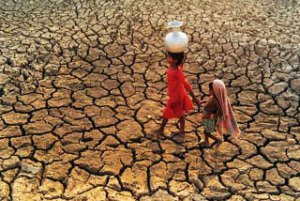
Add Pingback
Category List
nutrition (3)
rainforests (2)
Debunking Myths (1)
world hunger (2)
Announcements (1)
sustainability of water (1)
ocean depletion (3)
food choice (4)
government programs (2)
global depletion (3)
Agriculture (1)
Social Perception (1)
Tag List
meat operations (1)
shark fins (1)
health (3)
climate change (1)
bycatch (1)
habitat destruction (2)
meat export (1)
ecosystems (1)
grass fed beef (3)
ecoregions (1)
fishing (5)
farming (1)
air pollution (1)
australia beef (1)
japan fishing (1)
health benefits (2)
resources (2)
environment (1)
koalas (1)
loss of resources (1)
dairy operations (1)
vegetarian diet (1)
starving children (1)
choice of food (6)
diet (3)
organic produce (1)
Dr. Richard Oppenlander, Andrew Zimmern, octopus, eating animals, Comfortably Unaware (1)
food responsibility (2)
ocean life (1)
organic agriculture (1)
world conversation (1)
chronic disease (1)
sharks (1)
omega 3s (1)
amazon destruction (1)
wheat production (1)
animal products (6)
global hunger (3)
extinction (2)
agriculture (9)
world crops (3)
food supply (1)
veganism (2)
overfishing (2)
food waste (1)
marine species (1)
government subsidies (3)
michael pollan (1)
health care (3)
world beef producers (1)
sheep (1)
vegan diet (1)
drought (1)
biodiversity (5)
water depletion (2)
Dr. Oz (1)
meat import (1)
obesity (1)
world poverty (1)
lifestyle (1)
commodities (1)
organic food (1)
government food programs (2)
rainforests (2)
oceans (3)
sustainable oceans (3)
nutrition education (1)
land use (6)
third world hunger (1)
loss of biodiversity (1)
national healthcare costs (1)
global land use (1)
farm subsidies (1)
grain production (1)
tax dollars (1)
global depletion (11)
water pollution (1)
fish (4)
food awareness (1)
deforestation (3)
water management (1)
ocean ecosystem (5)
uses of water (1)
australia livestock (1)
vegetarian (3)
oxygen (1)
land depletion (2)
rainforest depletion (2)
ocean destruction (4)
Mehmet Oz (1)
non-profit, awareness, Dr. Richard Oppenlander, true sustainability, relative sustainability (1)
livestock (4)
species loss (1)
endangered species (4)
fishermen (1)
health risks (3)
africa (1)
diets (1)
oprah (1)
world hunger (5)
livestock feed (1)
beef import (3)
meat production (1)
plant based diet (1)
hunger (2)
poverty (1)
rainforest ecology (1)
agriculture system (1)
starving people (1)
bluefin tuna (1)
ocean depletion (2)
sea life (3)
vegan challenge (1)
food politics (5)
food (3)
vegan (1)
calorie count (1)
healthy weight (1)
australia (1)
food choice (9)
sustainability (6)
costs of food (1)
threatened species (1)
clean air (1)
diseases (1)
beef (1)
beef production (1)
farm bill (2)
healthy planet (1)
industrial farming (1)
government spending (1)
nutrition (3)
Tag Cloud
Archive
2011
February
Russia, Wheat Shortages, and Your Food
Vote with Our Minds, Not Our Forks
The Fish Facade: Part II
Water: Escalating Concerns
April
May
June
July
August
September
October
November
December
2012
Introducing INSPIRE AWARENESS NOW organization
Be Aware the Myth #1
March
April
May
June
July
August
September
October
November
December
